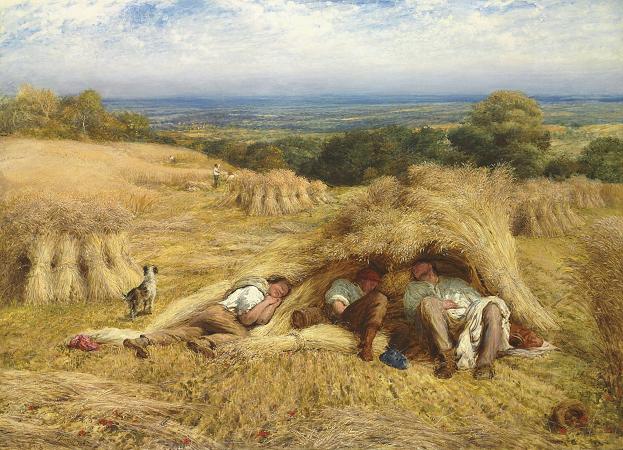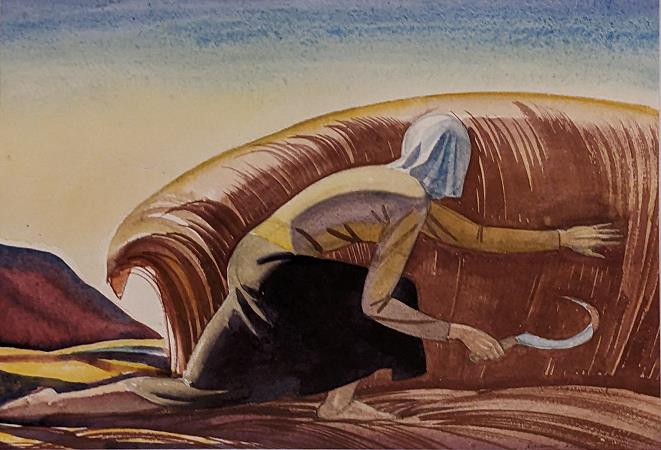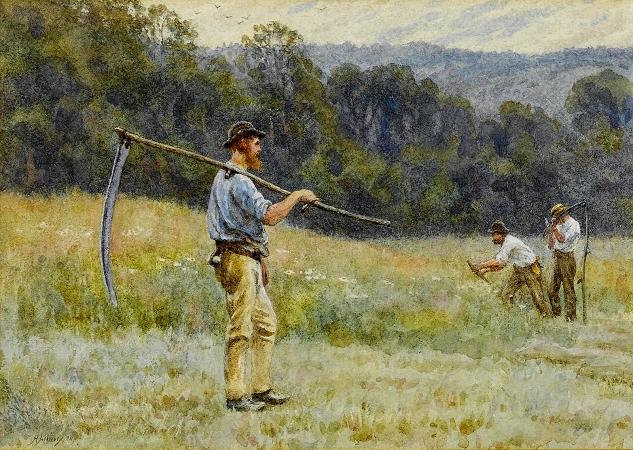Reaper. A reaper is a farm implement or person that reaps crops at harvest when they are ripe. Usually the crop involved is a cereal grass. The first documented reaping machines were Gallic reaper that was used in modern-day France during Roman times. The Gallic reaper involved a comb which collected the heads, with an operator knocking the grain into a box for later threshing. Most modern mechanical reapers cut the grass; most also gather it, either by windrowing it or picking it up. Modern machines that not only cut and gather the grass but also thresh its seeds, winnow the grain, and deliver it to a truck or wagon it are called combine harvesters or simply combines; they are the engineering descendants of earlier reapers. Hay is harvested somewhat differently from grain; in modern haymaking, the machine that cuts the grass is called a hay mower or, if integrated with a conditioner, a mower-conditioner. As a manual task, cutting of both grain and hay may be called reaping, involving scythes, sickles, and cradles, followed by differing downstream steps. Traditionally all such cutting could be called reaping, although a distinction between reaping of grain grasses and mowing of hay grasses has long existed; it was only after a decade of attempts at combined grain reaper/hay mower machines that designers of mechanical implements began resigning them to separate classes. Mechanical reapers substantially changed agriculture from their appearance in the 1830s until the 1860s through 1880s, when they evolved into related machines, often called by different names, that collected and bound the sheaves of grain with wire or twine. Hand reaping is done by various means, including plucking the ears of grains directly by hand, cutting the grain stalks with a sickle, cutting them with a scythe, or a scythe fitted with a grain cradle. Reaping is usually distinguished from mowing, which uses similar implements, but is the traditional term for cutting grass for hay, rather than reaping cereals. The stiffer, dryer straw of the cereal plants and the greener grasses for hay usually demand different blades on the machines. The reaped grain stalks are gathered into sheaves, tied with string or with a twist of straw. Several sheaves are then leant against each other with the ears off the ground to dry out, forming a stook. After drying, the sheaves are gathered from the field and stacked, being placed with the ears inwards, then covered with thatch or a tarpaulin; this is called a stack or rick. In the British Isles a rick of sheaves is traditionally called a corn rick, to distinguish it from a hay rick. Ricks are made in an area inaccessible to livestock, called a rick-yard or stack-yard. The corn-rick is later broken down and the sheaves threshed to separate the grain from the straw. Collecting spilt grain from the field after reaping is called gleaning, and is traditionally done either by hand, or by penning animals such as chickens or pigs onto the field. Hand reaping is now rarely done in industrialized countries, but is still the normal method where machines are unavailable or where access for them is limited. The more or less skeletal figure of a reaper with a scythe-known as the Grim Reaper-is a common personification of death in many Western traditions and cultures. In this metaphor, death harvests the living, like a farmer harvests the crops. A mechanical reaper or reaping machine is a mechanical, semi-automated device that harvests crops. Mechanical reapers and their descendant machines have been an important part of mechanized agriculture and a main feature of agricultural productivity. The 19th century saw several inventors in the United States claim innovation in mechanical reapers. The various designs competed with each other, and were the subject of several lawsuits. Obed Hussey in Ohio patented a reaper in 1833, the Hussey Reaper.Made in Baltimore, Maryland, Hussey's design was a major improvement in reaping efficiency. The new reaper only required two horses working in a non-strenuous manner, a man to work the machine, and another person to drive. In addition, the Hussey Reaper left an even and clean surface after its use. The McCormick Reaper was designed by Robert McCormick in Walnut Grove, Virginia. However, Robert became frustrated when he was unable to perfect his new device. His son Cyrus asked for permission to try to complete his father's project. With permission granted, the McCormick Reaper was patented by his son Cyrus McCormick in 1834 as a horse-drawn farm implement to cut small grain crops.
more...







